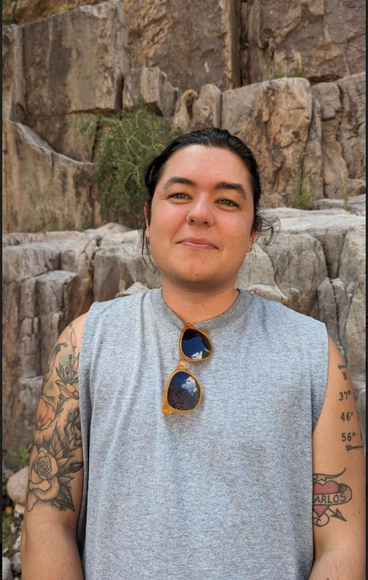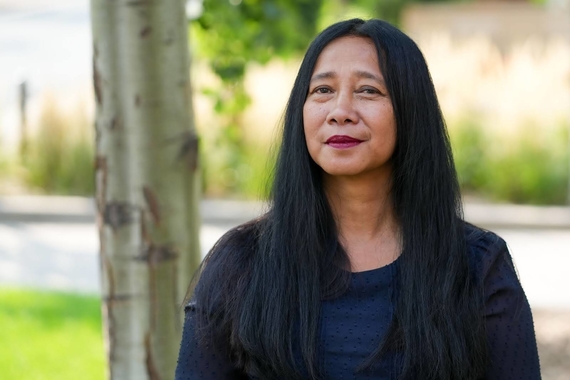“Not all is Lost”: The Violence of Colonial Architecture at the US-Mexico Border

Isaac Esposto is a graduate student in the Department of Gender, Women & Sexuality Studies and a recipient of the 2023 Fink Summer Research Fellowship. They spent the summer in the Sonoran Desert, where they researched the ways colonialism is reflected and reinforced by the architecture of the southern border.
Tell us about your project
The working title of this project is Border Architecture of Silent Killings: Colonial Anxiety Takes the Form of a Metal Wall. In the past, present, future, and in order to make clear how the United States as an empire/nation/state has implemented power through its architecture and infrastructure, my central question is one of the violence of space and movement along the southern border. What can the wall, checkpoints, barbed wire, rumble strips, detention centers, and surveillance structures actually tell us about who is “human” enough to be granted entry? How did we come to be here with this border violence? Why do hundreds of people die each year attempting to cross the Sonoran Desert? How can this violent exclusion of a gendered and racialized other only be facilitated through architectural design as it is weaponized to facilitate governmental agendas? Where do we form a consensus to head towards next?
Clusters of colonial production, extraction, and regulations were found in the 18th-century mining camps just as they are found today in the ICE transportation networks for “deportation support” and the standing army of white supremacists militia groups roving about the wall. These nodes that power flows through are often subterranean, epiphenomenal, quotidian; we lose our tongues explaining them.
The genesis of this project comes from living within a Southern Arizona community and my work with a Humanitarian Aid group working along the Arizona-Sonoran border. This summer in particular has been one of intense heat, omnipresent surveillance, and necropolitical abandonment of people fleeing the catastrophic results of climate change, US interventionism, and late-stage capitalism.
Here is what I would like people to understand: not all is lost, border violence and the state-sanctioned murder of Brown, Black, and Indigenous communities is not foreclosed. There has existed a time before it and there will exist a time after. Instead, there are escape hatches, ways we can dismantle these architectures of killing so that we might better be able to envision and embrace worlds open to care and rebellion. Different doorways we can walk through to care for one another in the detritus of globalization.
What's exciting about your project? What has this award allowed you to do?
This summer fieldwork and archival work have laid the foundation for an article for publication titled “Architecture of Silent Killings: Colonial Anxiety Takes the Form of a Metal Wall'' which I plan on submitting to journals sometime in early spring. In addition, this summer research project will be carried on into the Fall semester as I begin my Interdisciplinary Doctoral Fellowship through the Institute for Advanced Study. I believe this has given me a solid footing for taking on larger research questions that I will be incorporating into the first section of my dissertation.
This generous award has given me the time, space, and energy to move between archive and fieldwork; to spend time unearthing the letters of early architectural developments in the Spanish colonial era of the Sonoran Desert as well as hiking through the mountain’s heat to administer humanitarian aid. The aspect I’m most excited about in this project is the collapse between the past and present, where the helical nature of time comes into focus in order to ground the history of racialized border policing into the here and now so that we might be better able to contextualize the analytics of contemporary border imperialism. For example, my research at the University of Arizona’s Special Collections archive provided a paper trail which exposes the history of ongoing funding the US government has provided for militarized architecture along the border from the fort system to the detention center.
Often the subterranean structures of violence are granted an eternal reputation in our border imaginary. Tracking the connections between architecture, infrastructure, capital-class formation, and investments in the project of settler colonialism helps me to foreground the intellectual dimension of architecture. Establishing these linkages between the field of architecture and developments in border policy and migration studies opens up my evolving critical engagement between architecture, ethical obligations of design, and broader questions of border policing, carcerality, and surveillance of vulnerable communities.
As the architect Bernard Tschumi wrote in 1976, “Architecture is defined by the actions it witnesses as much as by the enclosures of its walls.” Moving with his proclamation, I believe that we must ground border policy, militarization, and policing equally in the material manifestations of space and its inherently disciplinary design, in addition to qualitative conceptions of gender and race.
What challenges have you faced?
One of the largest challenges in completing fieldwork this summer was the very real consequences of climate change. This year, Tucson set a new record of 11 consecutive days of temperatures exceeding 111 degrees by the middle of July. In other areas of Southern Arizona where I traveled, such as the community of Ajo, we have experienced even hotter temperatures with multiple days’ highs hitting 114 degrees.
Another similar challenge I faced was accessing certain areas in Southern Arizona due to a large wildfire in the Tumacacori and Atascosa mountains called the Beehive fire. I’m in the fortunate position where I have access to reliable AC and spaces where I can cool down. However, I think this highlights the importance of research that explores who has access to spaces safe from the heat and who is left outside, such as the “roughly 50 migrants confined in a chain-link pen” at the Ajo Border Patrol station.
How is your project making a difference in the world?
In contrast to these biopolitical mechanisms that allow political powers to dictate who must die and who can live, I direct this cross-genre creative work as one that provides concrete guides towards healing. I do this for those engaged in border care work, those harmed by the violence of border architecture (which I argue is all of us) and the theoretical implications of it. Pushing against consumption-based neoliberal capital “care” acts, this work expands the temporal and spatial limits surrounding what care looks like, who performs it, and aims to tear open rhetorical limitations to expose hidden possibilities against imperial violence in the borderlands.
Working in conversation with hybrid-poetic texts such as Gloria Anzaldúa’s Borderlands/La Frontera, Carmen Giménez Smith’s Be Recorder, and Susan Briante’s Defacing the Monument, I hope this scholarship can weave together decolonial theory, scholarship on design, and poetics in order to destabilize understandings of proper forms of “structures”—highlighting their limits, erasures, and gaps for intervention by border communities.
How has the award made a difference to your career?
This award has allowed me to spend time with the communities and work I find fulfilling to me not only as an academic but as a person living along the border. There is sometimes pressure to separate the work of scholarship from the lives we live outside of campus. However, in this way, the ethical and political considerations that inform my day to day also have the porousness to influence and resonate in the commitments I carry forth in my academic work. In addition to gaining practical skill sets in archival research and theoretical analysis, I have also had the time and space to build a solid foundation of working through the nuances of auto-ethnographic scholarship.
What partnerships has this award helped you develop and nurture?
This award has helped to nurture the relationships I have with both people and places here in the Sonoran Desert. I have gotten to build a working relationship with a number of archivists in the Tucson area that I feel will be generative for future research.
Support outstanding fellows like Isaac Esposto by making a gift to the Beverly and Richard Fink Graduate Fellowship Fund today!
This story was edited by Max Pritchard, an undergraduate student in CLA.


